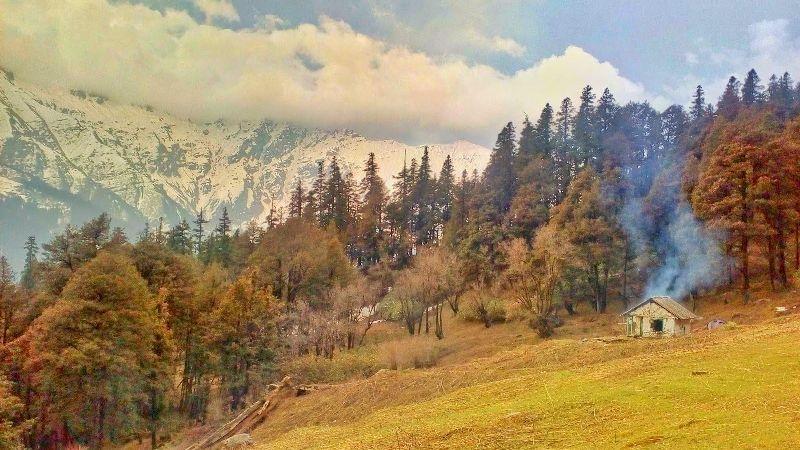
Image credits: Er.ashu.88 / CC BY-SA 4.0
It's here, it's now, and it's killing — as the world reels under a pandemic, there seems to be no 'happy-ever-after' for the planet. The crisis of climate change is threatening our land, forests, mountains, oceans and poles. Animals and plants, many endemic to specific areas, are either perishing or finding ways to adapt to the warming climate. In many cases, the climate is driving how plants and animals are distributed. For example, apple orchards in the Himachal Pradesh are now shifting upwards in search for a more conducive climate. The lofty Himalayan peaks in Kashmir are no different.
Now, a recent study finds how devastating climate change is for the alpine vegetation found at such high elevations in these mountains. Alpine vegetation consists of plants that grow at high elevations, where the harsh climate can only support a few species adapted to survive there. The study involved researchers from the University of Kashmir, Srinagar, Indian Space Research Organization, Ahmedabad, along with their collaborators from Czechia. It was published in the journal Frontiers in Plant Science.
Previous studies that examined the alpine vegetation of snow-covered mountain peaks in Europe and the US have shown a change in the composition of plants with warming. In the Indian Himalayas, studies have recorded a warming of over a degree and a decrease in annual rainfall. "However, we have not studied the impact of such changes on the biodiversity and species distribution. Our study is first of its kind in the Western Himalaya and India", says Dr Maroof Hamid. He is a researcher at the Centre for Biodiversity and Taxonomy, Department of Botany, University of Kashmir and the lead author of the study.
The researchers studied the vegetation on four summits in the Apharwat mountain located in North-Western Himalayas. The four summits, at different elevations, differ in their climatic conditions and temperature. The researchers collected details of the plants, the soil temperature and rainfall in these regions, in 2014 and again in 2018. They then analysed the differences in their data. Between 2014 and 2018, data from the India Meteorological Department, Srinagar, shows a 0.4°C increase in ambient temperature, 1.5°C increase in soil temperature and a decrease of 38.9 mm in annual rainfall. The researchers wanted to find how this difference impacted the plants in the region.
In 2014, the data collected showed that summits at lower elevations had more plant species compared to those in peaks higher up. Even within each summit, regions with warmer soil were rich in the number of plant species. As soil temperature and climatic temperature increased, species richness among plants and the vegetation cover increased. All the four peaks studied had similar species of plants, and very few were exclusive to each.
In comparison, data from 2018 revealed an increase from 138 to 168 in the total number of plant species in the region in three of the four summits. At the highest summit situated at 3740 metres, there was a decrease in the number of species. The researchers attribute this decrease to local extinctions and replacement of cold-loving plant species by those that are usually found in low elevation and warmer climates, due to global warming.
"In alpine ecosystems, climate change drives the shifting of plant species due to two major processes. One is colonisation, where sites become suitable for new plants, and other is the extinction of existing plant species at unsuitable sites," explains Dr Anzar, assistant professor at University of Kashmir. "Studies suggest that extinctions are more frequent in slow-growing, cold-loving species found in very high elevations. Colonisation is more frequent in warm-loving species from lower elevations."
The study also found that by 2018, new species of plants which were not reported from lower peaks in 2014, were found. These include Cimicifuga kashmiriana, Gigantic Himalayn Balsam (Impatiens sulcata), and hawkweed oxtongue (Picris hieracioides). Three species of plants, which were reported in the highest summit in 2014 were absent in 2018. The upward movement of warm-loving plants would accelerate further and increase local extension, if global warming persists at the same rate, say the researchers.
"The present study provides empirical evidence to substantiate the sensitivity of alpine vegetation in the Himalaya to the ongoing climate change," shares Dr Anzar and Dr Maroof. The findings indicate that climate-induced changes are now seen in plants found at the world's highest peaks. These changes may have significant consequences not only for biodiversity but also for the ecosystem. "Alpine ecosystems harbour disproportionately high ratios of unique species, which may be adversely affected by future climate change, particularly those whose climatic environments are set to disappear" they conclude.






